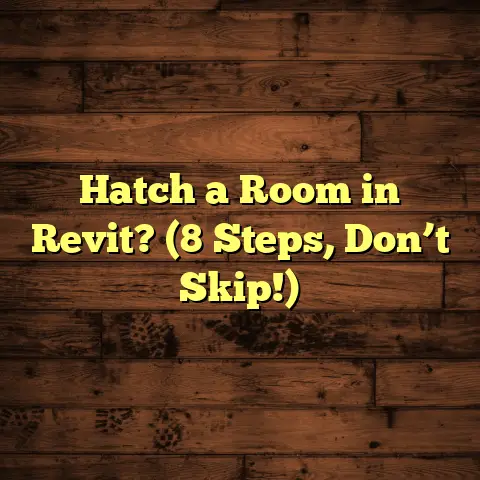Fill Void Under Floor: How? (6 Subfloor Fixes!)
Isn’t it ironic how we often believe a house is only as strong as its walls, completely ignoring the sneaky voids lurking beneath our feet?
While we fret over paint colors and furniture placement, the real threat might just be hiding beneath the floorboards, waiting to make its presence known with every creak and groan.
As a flooring contractor with years of experience, I’ve seen firsthand the havoc these hidden spaces can wreak.
Let’s dive into the world beneath our floors and learn how to tackle these voids head-on!
Section 1: Understanding the Problem
So, what exactly is a void under the floor?
Simply put, it’s an empty space between your flooring and the subfloor (or the ground, in some cases).
These voids aren’t just cosmetic; they can seriously compromise your home’s structure.
Voids can occur for several reasons:
- Settling: Over time, the ground beneath your home can shift, creating gaps.
- Water Damage: Leaks and moisture can rot away wooden subfloors, leaving voids.
- Pest Activity: Termites and other wood-boring insects can feast on your subfloor, creating tunnels and voids.
These voids have serious implications.
Think about it: your floor supports everything in your room – furniture, people, everything!
Voids weaken that support, leading to:
- Structural Instability: Sagging floors can eventually lead to wall cracks and foundation problems.
- Safety Risks: A weak floor can collapse, causing injury.
- Energy Inefficiency: Gaps let in drafts, increasing your heating and cooling bills.
According to the American Society of Civil Engineers (ASCE), addressing structural issues early can save homeowners thousands of dollars in the long run.
Ignoring those creaks and groans can be a costly mistake!
Section 2: Identifying the Void
Okay, so how do you know if you actually have a void under your floor?
Here are some telltale signs I’ve learned to look for:
- Uneven Floors: This is the most obvious sign.
Use a level to check for dips or slopes. - Cracks in Walls: Especially around doors and windows.
This can indicate structural movement due to a weakened subfloor. - Popping Sounds: Annoying creaks and pops when you walk across the floor are classic void indicators.
- Sagging: Visually inspect the floor for any noticeable sagging or bowing.
Let’s get a little more hands-on with some tools and techniques:
- Tapping on the Floor: A solid floor will sound firm and consistent.
A void will sound hollow. - Using a Level: Place a level on the floor and check for significant deviations.
A long level is best for detecting subtle changes. Checking for Moisture: Use a moisture meter to check for dampness in the flooring or subfloor.
High moisture levels can indicate water damage and potential voids.-
Moisture Meter Readings and Interpretation
Reading (%) Interpretation Below 5% Indicates very dry conditions.
Wood is likely too dry, which can lead to cracking and splitting.6-12% Ideal moisture content for most interior wood applications.
Wood is stable and less prone to movement.13-17% Elevated moisture levels.
May indicate a potential moisture problem or recent exposure to moisture.
Monitoring is advised.18-25% High moisture levels.
Indicates a definite moisture problem that needs addressing.
Wood is at risk of mold growth and decay.Above 25% Saturated conditions.
Wood is severely wet and at high risk of rapid decay and mold infestation.
Immediate action is required to dry the wood and address the source of moisture.
-
Don’t just rely on one sign.
Look for a combination of these indicators to confirm your suspicions.
If you’re unsure, it’s always best to call in a professional for a thorough inspection.
I’ve seen many homeowners misdiagnose the problem, leading to more costly repairs down the road.
Section 3: Preparing for Repairs
Alright, you’ve identified a void. Now what?
Before you start tearing up your floor, let’s talk about preparation.
Safety first! Here’s what you’ll need:
- Safety Glasses: Protect your eyes from dust and debris.
- Dust Mask or Respirator: Especially important if you suspect mold or pest activity.
- Gloves: Protect your hands from splinters and chemicals.
- Hearing Protection: Power tools can be loud.
Now for the tools:
- Pry Bar: For removing flooring and subfloor.
- Measuring Tape: Accurate measurements are crucial for proper repairs.
- Plywood: For replacing damaged subfloor sections.
- Circular Saw or Jigsaw: For cutting plywood.
- Drill/Driver: For screwing in new subfloor.
- Screws or Nails: For securing the subfloor.
- Shims: For filling small voids.
- Level: To ensure your repairs are even.
Assessing the scope of the repair is critical.
How big is the void?
How many voids are there?
What caused the void in the first place?
Addressing the cause is just as important as filling the void itself.
For example, if water damage caused the void, you need to fix the leak before you repair the floor.
Otherwise, you’re just setting yourself up for future problems.
Remember, a little planning goes a long way.
Take your time, gather your materials, and understand the problem before you start swinging that hammer.
Section 4: Six Subfloor Fixes
Okay, let’s get to the meat of the matter: fixing those voids!
I’m going to walk you through six different methods, from simple to more complex.
Fix 1: The Shim Method
This is the simplest method, ideal for small voids (less than 1/4 inch).
Shims are thin, tapered pieces of wood or plastic that you can slide into the gap to provide support.
Here’s how to do it:
- Locate the Void: Identify the area where the floor feels uneven or hollow.
- Lift the Flooring (If Necessary): Gently pry up the flooring around the void.
You might need a pry bar for this.
Be careful not to damage the surrounding flooring. - Insert the Shim: Slide the shim into the void, with the thicker end providing the most support.
- Test the Floor: Walk on the area to see if the shim has eliminated the void.
- Trim the Shim (If Necessary): If the shim sticks out, trim it flush with the subfloor using a utility knife or saw.
- Secure the Flooring: Reattach the flooring using nails, screws, or adhesive.
Tips for Effective Application:
- Use multiple shims for larger areas.
- Don’t force the shims in too tightly, as this can create a bulge in the floor.
- Use construction adhesive to hold the shims in place.
I’ve used this method countless times for quick fixes.
It’s amazing how much difference a few well-placed shims can make!
Fix 2: Adding Support Beams
For larger voids or areas where the subfloor is significantly weakened, you might need to add support beams or joists.
This is a more involved process, but it provides a much more robust solution.
Here’s the basic process:
- Access the Subfloor: Remove the flooring to expose the subfloor and the joists beneath.
- Measure the Span: Measure the distance between the existing joists.
- Cut the Support Beam: Cut a new joist to the correct length.
Use the same dimensions as the existing joists. - Install the Support Beam: Position the new joist between the existing joists, ensuring it’s flush with the top of the subfloor.
- Secure the Support Beam: Attach the new joist to the existing joists using screws or nails.
Use metal joist hangers for added strength. - Replace the Subfloor: If the subfloor is damaged, replace it with new plywood.
- Reinstall the Flooring: Reattach the flooring.
Tools and Materials Needed:
- Lumber for the support beam (same dimensions as existing joists)
- Metal joist hangers
- Screws or nails
- Circular saw
- Drill/driver
- Measuring tape
- Level
Important Note: This method requires a good understanding of structural principles.
If you’re not comfortable working with framing, it’s best to hire a professional.
Fix 3: Foam Injection
Foam injection is a great option for filling larger voids, especially in hard-to-reach areas.
Polyurethane foam expands to fill the space, providing support and insulation.
Here’s how it works:
- Drill Injection Holes: Drill small holes in the floor or subfloor above the void.
- Insert Injection Nozzle: Insert the nozzle of the foam injection gun into the holes.
- Inject the Foam: Inject the polyurethane foam into the void.
The foam will expand to fill the space. - Allow the Foam to Cure: Allow the foam to cure according to the manufacturer’s instructions.
- Trim Excess Foam: Once the foam is cured, trim any excess foam that protrudes from the holes.
- Patch the Holes: Patch the injection holes with wood filler or patching compound.
Detailed Procedure for Application:
- Safety Precautions: Wear gloves, safety glasses, and a respirator.
Polyurethane foam can be irritating to the skin and lungs. - Choosing the Right Foam: Use a foam specifically designed for filling voids under floors.
Look for a low-expansion foam to avoid lifting the floor. - Controlling Expansion: Inject the foam slowly and monitor the expansion.
Avoid overfilling the void, as this can damage the floor.
Benefits of Foam Injection:
- Waterproof: Polyurethane foam is waterproof, preventing future water damage.
- Insulating: Foam provides insulation, reducing energy costs.
- Fills Irregular Spaces: Foam can fill even the most irregular voids.
I’ve used foam injection in many situations where access was limited.
It’s a versatile and effective solution.
Fix 4: Plywood Replacement
If the subfloor itself is damaged or rotted, you’ll need to replace it with new plywood.
This is a common repair, especially in areas prone to water damage.
Here’s a detailed guide:
- Remove the Flooring: Carefully remove the flooring around the damaged area.
- Cut Out the Damaged Plywood: Use a circular saw or jigsaw to cut out the damaged section of subfloor.
Cut along the joists for easy attachment. - Measure and Cut New Plywood: Measure the opening and cut a new piece of plywood to fit.
Use the same thickness as the existing subfloor. - Install the New Plywood: Place the new plywood in the opening and secure it to the joists with screws or nails.
- Reinstall the Flooring: Reattach the flooring.
Measuring, Cutting, and Securing the New Panels:
- Accurate Measurements: Double-check your measurements before cutting the plywood.
- Clean Cuts: Use a sharp blade and cut along a straight line for a clean, professional look.
- Stagger the Seams: If you’re replacing a large area, stagger the seams between the plywood panels for added strength.
- Use Construction Adhesive: Apply construction adhesive to the joists before attaching the plywood.
Choosing the Right Plywood:
- Subfloor Grade Plywood: Use plywood specifically designed for subfloors.
It’s typically thicker and more durable than other types of plywood. - Moisture-Resistant Plywood: If the area is prone to moisture, use moisture-resistant plywood.
Replacing damaged plywood is a fundamental skill for any flooring contractor.
It’s essential for maintaining a strong and stable subfloor.
Fix 5: Concrete Slab Repair
For homes with concrete floors, voids can occur due to settling or erosion.
Repairing these voids requires different techniques and materials.
Here’s how to fill voids in concrete slabs:
- Clean the Area: Remove any loose debris or dirt from the void.
- Prepare the Surface: Etch the concrete surface with a concrete etcher to improve adhesion.
- Apply a Bonding Agent: Apply a concrete bonding agent to the surface.
- Fill the Void: Fill the void with a self-leveling compound or epoxy material.
- Allow to Cure: Allow the material to cure according to the manufacturer’s instructions.
- Grind and Smooth: Grind and smooth the surface to match the surrounding concrete.
Step-by-Step Instructions:
- Self-Leveling Compound: Mix the self-leveling compound according to the manufacturer’s instructions.
Pour the compound into the void and allow it to flow and level out. - Epoxy Material: Mix the epoxy material according to the manufacturer’s instructions.
Apply the epoxy to the void using a trowel.
Choosing the Right Materials:
- Self-Leveling Compound: Use a self-leveling compound specifically designed for concrete floors.
- Epoxy Material: Use an epoxy material that is compatible with concrete and provides good adhesion.
Important Considerations:
- Large Voids: For large voids, you may need to use multiple layers of self-leveling compound or epoxy material.
- Cracks: If the concrete slab has cracks, you’ll need to repair them before filling the void.
Concrete slab repair requires specialized materials and techniques.
If you’re not comfortable working with concrete, it’s best to hire a professional.
Fix 6: Professional Help
Sometimes, the problem is too big or too complex to handle on your own.
Knowing when to call in a professional is crucial.
Here are some scenarios where professional help is recommended:
- Extensive Damage: If the damage is widespread or severe, it’s best to consult a professional.
- Structural Issues: If you suspect structural issues, such as foundation problems, it’s essential to hire a structural engineer or contractor.
- Unsure of the Cause: If you’re not sure what caused the void, a professional can diagnose the problem and recommend the best solution.
- Lack of Experience: If you’re not comfortable working with tools or materials, it’s best to leave the job to a professional.
What to Expect When Hiring a Contractor:
- Inspection: The contractor will inspect the floor and subfloor to assess the damage.
- Diagnosis: The contractor will diagnose the cause of the void.
- Estimate: The contractor will provide you with a written estimate for the repairs.
- Permits: The contractor will obtain any necessary permits.
- Repairs: The contractor will perform the necessary repairs.
Finding a Reputable Contractor:
- Get Recommendations: Ask friends, family, or neighbors for recommendations.
- Check Online Reviews: Read online reviews to see what other customers have to say.
- Verify Licensing and Insurance: Make sure the contractor is licensed and insured.
- Get Multiple Bids: Get bids from multiple contractors to compare prices and services.
Don’t be afraid to ask questions and get a clear understanding of the repair process.
A good contractor will be happy to explain everything in detail.
Section 5: Aftercare and Maintenance
You’ve fixed the void!
Now, let’s talk about keeping your subfloor healthy for years to come.
Here are some suggestions for maintaining a healthy subfloor environment:
- Moisture Control: This is the most important factor.
Fix any leaks promptly and ensure proper ventilation in crawl spaces and basements. - Regular Inspections: Check your floors regularly for signs of damage or voids.
Early detection can prevent small problems from becoming big ones. - Preventive Measures: Consider using moisture barriers in crawl spaces and basements to prevent moisture from entering the subfloor.
The Importance of Moisture Control:
- Mold Growth: Moisture can lead to mold growth, which can damage the subfloor and cause health problems.
- Wood Rot: Moisture can cause wood rot, which weakens the subfloor.
- Pest Infestation: Moisture can attract pests, such as termites, which can damage the subfloor.
Preventive Measures to Avoid Future Voids:
- Proper Drainage: Ensure proper drainage around your home to prevent water from pooling near the foundation.
- Gutter Maintenance: Clean your gutters regularly to prevent water from overflowing and damaging the subfloor.
- Seal Cracks: Seal any cracks in the foundation to prevent water from entering the crawl space or basement.
Regular maintenance is key to preventing future problems.
A little effort now can save you a lot of time and money in the long run.
Closing
Addressing voids under the floor promptly is crucial for maintaining the structural integrity and safety of your home.
Understanding the various repair methods empowers you to take charge of your living spaces.
Embrace the irony of a stable home resting on invisible foundations.
Remember, informed decisions lead to lasting comfort and peace of mind.
Don’t let those sneaky voids undermine your home’s foundation!
Take action, be proactive, and enjoy the solid ground beneath your feet.
You got this!




